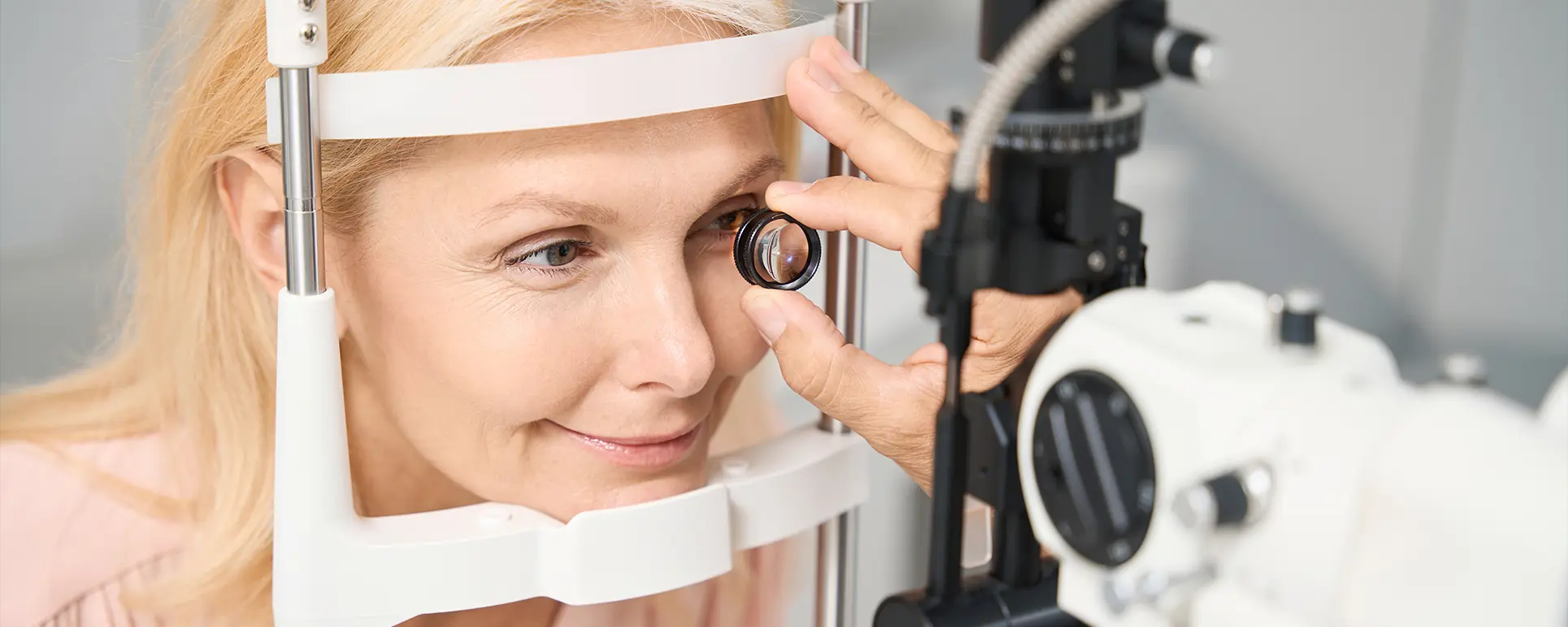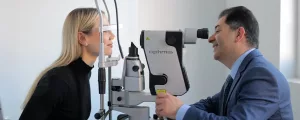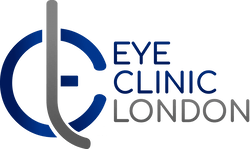Is Refractive Lens Exchange Painful?

For those considering refractive lens exchange (RLE) to improve their vision, the thought of discomfort during the procedure or recovery can be a concern. Whether you’re dealing with presbyopia, cataracts, or significant refractive errors, RLE is a popular solution. But just how painful is the procedure?
In this article, I’ll walk you through everything you need to know about pain and comfort during refractive lens exchange treatment in London, including the anaesthetic process, what you’ll feel during the procedure, and tips for a smooth recovery. By the end, you’ll have a clear understanding of what to expect and how to manage any discomfort.
What Is Refractive Lens Exchange (RLE)?
Before diving into the specifics of pain, it’s helpful to understand exactly what refractive lens exchange is. RLE is a procedure where your eye’s natural lens is replaced with an artificial intraocular lens (IOL) to correct vision problems like presbyopia, myopia, hyperopia, and cataracts.
It’s essentially the same procedure as cataract surgery, but it’s used for vision correction in people who don’t yet have cataracts. RLE is an ideal option for those over 40 who are experiencing presbyopia or those who want to reduce their dependence on glasses or contact lenses.
Anaesthesia During Refractive Lens Exchange

If you’re considering Refractive Lens Exchange (RLE), it’s natural to wonder what the procedure will feel like. A lot of people worry about whether it will be painful. The good news is that, with the right anaesthesia, RLE is virtually pain-free. The team takes every step to make sure you feel comfortable and relaxed from start to finish.
Numbing Eye Drops
Before anything else, your surgeon will apply numbing drops directly to your eyes. These drops work quickly to ensure that you don’t feel any pain during the procedure. You might still notice a little pressure or movement, but it’s gentle and completely normal. Most patients describe it as a slight sensation rather than discomfort. The drops take care of the pain so you can focus on the experience without worry.
Mild Sedation
Alongside the numbing drops, mild sedation is often provided through an intravenous (IV) line. This is a gentle, relaxing medication that helps you stay calm during the surgery. You’ll remain awake and aware, which means you can communicate with your surgeon if needed, but you won’t feel anxious or tense. Many patients say it feels like a soothing calm washes over them, allowing them to remain comfortable and relaxed for the entire procedure. You won’t fall asleep completely, but you will feel at ease, making the experience much less intimidating.
What You Might Feel During the Surgery
Because of the anaesthesia, the surgery itself is not painful. You may notice some gentle pressure as the surgeon works on your eye, but this is nothing to worry about it’s more of a sensation than discomfort. Another common experience is the bright light used to illuminate your eye during surgery. It can feel intense at first, but it’s temporary and nothing to be concerned about.
Some people also notice a slight tugging sensation as the lens is being replaced, but again, thanks to the numbing drops and sedation, it’s not painful. The goal is for you to feel relaxed and safe the entire time.
Why Anaesthesia Matters
The combination of numbing drops and mild sedation ensures that your RLE procedure is smooth, safe, and stress-free. You can stay awake, follow instructions, and even chat with your surgeon, all while feeling calm and comfortable. This approach allows your surgeon to focus on performing the procedure precisely, knowing that you’re at ease and pain-free.
What Happens During the RLE Procedure?

If you’re considering Refractive Lens Exchange (RLE), it’s completely normal to wonder what the surgery will actually involve. Understanding each step can help reduce any anxiety and give you a clear picture of what to expect. Here’s a detailed look at how the procedure usually unfolds:
Preparation
The first step is to get you comfortable and ready for surgery. Your surgeon will start by cleaning the area around your eyes to make sure everything is sterile. Next, numbing eye drops are applied. These drops ensure that your eyes are completely numb so you won’t feel any pain during the procedure.
At the same time, you may receive a mild sedative through an intravenous (IV) line. This helps you relax and feel calm. You’ll remain awake, but you won’t feel anxious or tense. Many patients describe it as a soothing sense of calm that allows them to focus on following simple instructions from the surgeon without stress.
Incision and Lens Removal
Once you’re ready, the surgeon makes a very tiny incision in your cornea. This opening is just large enough to allow access to your natural lens. Using advanced techniques, the surgeon carefully breaks up your natural lens and removes it from the eye.
Thanks to the anaesthesia, this step is completely painless. You might notice a little pressure or movement, but it’s more of a sensation than anything uncomfortable. Most patients are surprised at how smooth this part of the procedure feels.
Insertion of the Intraocular Lens (IOL)
After the natural lens is removed, the surgeon inserts an artificial lens called an intraocular lens (IOL). The IOL is folded so that it can pass through the small incision, and once inside, it unfolds into its correct position.
You won’t feel the lens being placed, and the process is quick. The goal is to restore your vision with precision, giving you clearer, sharper sight after the procedure.
Closing the Incision
One of the advantages of RLE is that the incision is so small it usually seals itself. This means sutures are rarely needed, which helps with a faster recovery and reduces the risk of complications.
Duration and Eye Selection
The entire surgery typically takes between 15 and 30 minutes per eye. Depending on your individual needs and your surgeon’s recommendation, you might have one eye done at a time, or both eyes treated in the same session. Either way, the focus is on keeping the procedure safe, efficient, and as comfortable as possible.
What You Might Experience
During the procedure, you may notice gentle pressure or a sense of movement in your eye, but thanks to the numbing drops and sedation, there is no pain. The bright surgical light can feel intense at first, but it’s only temporary. Many patients are amazed at how smooth the entire process feels and often remark on how quickly it seems to pass.
By understanding what happens during RLE, you can go into the procedure feeling informed, relaxed, and confident that your comfort and safety are the priority.
What Will I Feel After the Surgery?
Once your Refractive Lens Exchange (RLE) procedure is complete, you’ll usually be able to go home the same day. However, you’ll need someone to drive you because the sedation can leave you feeling a little drowsy or relaxed.
It’s normal to experience some mild discomfort immediately after surgery, but it’s usually manageable and short-lived. Here’s what you might notice in the hours and days following the procedure:
Mild Irritation
Your eyes may feel slightly irritated or gritty, similar to having something small in your eye. This is completely normal after any eye surgery and usually eases within a few hours or days. Lubricating eye drops prescribed by your surgeon can help soothe this sensation.
Light Sensitivity
It’s common to be more sensitive to light after the procedure. Bright lights may feel uncomfortable at first, so wearing sunglasses when you go outside can make a big difference. Over the next few days, your eyes will gradually adjust.
Watery or Dry Eyes
As the effects of the numbing drops wear off, you might notice your eyes are either watery or slightly dry. Both are normal reactions. Using the recommended eye drops can help keep your eyes comfortable while they heal.
Temporary Blurred Vision
Your vision may be a little blurred immediately after the surgery. This is normal and usually improves as your eyes adjust to the new lenses. Many patients notice clearer vision within a few hours, while full visual stability may take a few days.
Pressure Sensation
Some mild pressure in your eyes is also normal during the first few hours after surgery. It should gradually fade and is nothing to worry about.
Comfort Tips
- Rest your eyes as much as possible on the day of surgery.
- Avoid rubbing your eyes.
- Follow all post-operative instructions and use any prescribed drops as directed.
Overall, most patients find the recovery period surprisingly smooth. Your eyes may feel a little different at first, but with proper care, the sensations will gradually settle, and you’ll begin to enjoy the clearer vision that RLE provides.
How Long Does It Take to Recover from RLE?
One of the most common questions patients have about Refractive Lens Exchange (RLE) is how long it will take to recover. The good news is that RLE recovery is generally quicker and easier than many other eye surgeries, but it still requires some care and attention to ensure the best results. Here’s what you can expect:
Immediate Recovery (First 24–48 Hours)
Right after the procedure, it’s normal to feel some mild discomfort or pressure in your eyes. Most people find that over-the-counter pain relievers are enough to manage any soreness.
Your vision will probably be blurry at first, but don’t worry this is completely normal. As your eyes begin to adjust to the new lenses, your vision should improve gradually over the next few days.
Your surgeon will likely prescribe antibiotic and anti-inflammatory eye drops to reduce the risk of infection and control inflammation. It’s important to use these exactly as instructed to support proper healing.
Short-Term Recovery (1–2 Weeks)
Many patients are able to resume normal activities within just a couple of days. However, you should take care to avoid rubbing your eyes, getting water directly in them, or exposing them to very bright lights during the first week or two.
You may notice mild irritation, light sensitivity, or a watery sensation, but these symptoms should gradually subside as your eyes heal. Simple habits, like wearing sunglasses outdoors and resting your eyes when needed, can make the early recovery period much more comfortable.
Long-Term Recovery
While most of the initial healing happens fairly quickly, full visual recovery usually takes a few weeks. During this time, your vision will gradually improve, and your eyes will continue to adjust to the new intraocular lenses (IOLs).
It’s important to attend all follow-up appointments so your surgeon can check that your eyes are healing well and that the IOL is positioned correctly. These visits help ensure the best possible results and allow any concerns to be addressed early.
Tips for a Smooth Recovery
- Follow your surgeon’s instructions for eye drops and care.
- Avoid rubbing or pressing on your eyes.
- Rest your eyes if they feel tired or strained.
- Protect your eyes from bright light or dust when outdoors.
With proper care, most patients find the recovery process straightforward and are able to enjoy clearer, sharper vision within a few weeks.
Pain Management After RLE
Most patients don’t experience significant pain after Refractive Lens Exchange (RLE), but it’s normal to have some mild discomfort during the early recovery period. The good news is that with a few simple strategies, you can keep your eyes comfortable and support a smooth healing process.
Follow Post-Operative Care Instructions
Your surgeon will prescribe antibiotic and anti-inflammatory (steroid) eye drops. These are important to reduce inflammation and prevent infection. Make sure to use them exactly as directed.
If your eyes feel dry or irritated, lubricating eye drops can help. They keep your eyes comfortable and prevent dryness, which is common in the first few days after surgery.
Rest and Avoid Eye Strain
Try to give your eyes a break for the first 24–48 hours. Limit activities that require intense focus, such as reading, using your phone, or staring at a computer screen. Gentle rest allows your eyes to recover more quickly and can reduce any mild discomfort.
Protect Your Eyes from Bright Light
Your eyes may be more sensitive to light immediately after surgery. Wearing sunglasses when you go outside, especially on sunny days, helps protect your eyes and makes you feel more comfortable.
Avoid Rubbing Your Eyes
It might be tempting to rub your eyes if they feel itchy or irritated, but resist the urge. Rubbing can cause irritation or even affect the healing process, so it’s best to keep your hands away from your eyes.
Sleep with Your Head Elevated
Sleeping with your head slightly elevated on a pillow for the first few nights can help reduce swelling. This small adjustment makes a noticeable difference in comfort and supports faster recovery.
Additional Tips
- Take short breaks during activities that require visual focus.
- Stay hydrated, as this can help with overall eye comfort.
- Follow up with your surgeon if you notice anything unusual or persistent discomfort.
By following these simple steps, you can manage any mild discomfort after RLE and enjoy a smoother, more comfortable recovery. Most patients find that within a few days, their eyes feel almost completely normal.
Is the RLE Procedure Suitable for You?
RLE is suitable for people who suffer from refractive errors such as presbyopia, nearsightedness (myopia), or farsightedness (hyperopia), especially those who are in their 40s or 50s. The procedure is also ideal for patients who are experiencing early-stage cataracts or who want to reduce their reliance on glasses or contact lenses.
However, RLE may not be suitable for individuals who:
- Have significant corneal or retinal diseases.
- Are not healthy enough to undergo surgery.
- Are under the age of 40, as the natural lens still functions well at this age.
To determine if refractive lens exchange treatment in London is right for you, a detailed consultation with an experienced ophthalmologist is essential.
FAQs About Refractive Lens Exchange (RLE):
- Is RLE a painful procedure?
RLE is generally a pain-free procedure thanks to the combination of numbing eye drops and mild sedation. Most patients describe feeling only gentle pressure or slight sensations as the surgeon works on the eye. The bright light used during surgery may feel intense at first, but it is temporary and not painful. Thanks to anaesthesia, the entire procedure is designed to keep you comfortable and relaxed from start to finish. - Will I need general anaesthesia for RLE?
No, general anaesthesia is rarely used for RLE. The procedure typically relies on local anaesthesia in the form of numbing eye drops, sometimes combined with mild intravenous sedation. This approach allows you to stay awake and communicate with your surgeon while feeling calm and comfortable. It also reduces recovery time and lowers the risks associated with general anaesthesia. - How long does the surgery take?
RLE is usually a quick procedure. Each eye typically takes between 15 and 30 minutes to treat. Depending on your surgeon’s recommendation and your individual needs, both eyes can sometimes be treated in the same session, or each eye may be done separately. The short duration, combined with anaesthesia, makes the surgery a relatively straightforward experience. - What will I feel immediately after the surgery?
After RLE, it’s normal to experience mild irritation, a gritty sensation, or slight pressure in your eyes. You might also notice some light sensitivity, watery eyes, or temporary blurred vision as your eyes adjust to the new lenses. These sensations are usually short-lived and can be managed with prescribed eye drops, rest, and proper care. Most patients find that within a few hours or days, their eyes begin to feel comfortable again. - How quickly will my vision improve?
Initial improvements in vision can often be noticed within the first 24 to 48 hours after surgery. However, full visual recovery usually takes between one and three months, as your eyes gradually adjust to the intraocular lenses (IOLs). During this time, it’s important to attend follow-up appointments to ensure proper healing and optimal lens positioning. - Are there any restrictions after the surgery?
While RLE recovery is relatively quick, there are a few temporary precautions. You should avoid rubbing your eyes, exposing them to bright or dusty environments, and performing activities that strain your eyes for the first few days. Using prescribed drops, wearing sunglasses outdoors, and allowing your eyes to rest are all key steps in supporting a smooth recovery. - Can I return to normal activities after RLE?
Many patients notice they can get back to most daily activities within a few days. It’s still important to follow your surgeon’s advice regarding work, exercise, and screen use. Gentle activity is generally fine, but you should avoid strenuous exercise or anything that could impact your eyes until your surgeon confirms it’s safe. - Who is a good candidate for RLE?
RLE is most suitable for people over the age of 40 who are experiencing presbyopia, early-stage cataracts, or significant refractive errors like nearsightedness or farsightedness. It is also ideal for those who wish to reduce their reliance on glasses or contact lenses. However, RLE may not be recommended for individuals with significant corneal or retinal diseases, or for younger patients whose natural lens still functions well. - Is RLE safe?
When performed by an experienced ophthalmologist, RLE is considered a safe and effective procedure. Modern techniques and intraocular lenses have made the surgery highly predictable, and the risks of complications are relatively low. Following pre- and post-operative instructions carefully, attending follow-up appointments, and discussing any concerns with your surgeon are key to ensuring a safe outcome. - How can I manage discomfort after RLE?
While significant pain is uncommon, mild discomfort can occur in the early recovery period. Using prescribed antibiotic, anti-inflammatory, and lubricating eye drops as instructed can help manage irritation and dryness. Resting your eyes, avoiding rubbing, wearing sunglasses outdoors, and sleeping with your head slightly elevated can all support a comfortable and smooth recovery. Most patients find that these measures allow their eyes to feel normal within a few days.
Final Thoughts: Is Refractive Lens Exchange Painful?
Refractive lens exchange is a safe and effective way to improve your vision, and with modern anaesthetic techniques, the procedure itself is virtually painless. However, caring for your eyes properly after surgery plays a key role in ensuring a smooth recovery and protecting your long-term vision.
Simple habits, like using prescribed eye drops, avoiding rubbing your eyes, protecting them from bright light, and attending follow-up appointments, can make a big difference. The goal isn’t just to recover from surgery, but to maintain the clarity and comfort of your vision for years to come.
If you are considering refractive lens exchange treatment in London, you can contact us at Eye Clinic London for a consultation. Our experienced ophthalmologists will examine your eyes, explain your options, and guide you in choosing the approach that best suits your vision needs and lifestyle. Taking these steps now can have a lasting impact on the health of your eyes and the quality of your vision.
References:
- Porela-Tiihonen, S. et al. (2013)
‘A prospective study on postoperative pain after cataract surgery’. Acta Ophthalmologica, 91(3), pp. 270–275. Available at: https://doi.org/10.1111/aos.12082 - Porela-Tiihonen, S., 2013. ‘A prospective study on postoperative pain after cataract surgery’. Acta Ophthalmologica, 91(5), pp. 455-460. Available at: https://pmc.ncbi.nlm.nih.gov/articles/PMC3716556/
- Apil, A., 2014. ‘Topical anesthesia for cataract surgery: the patients’ perspective’. Journal of Cataract & Refractive Surgery, 40(7), pp. 1141-1146. Available at: https://pmc.ncbi.nlm.nih.gov/articles/PMC4094730/
- Toro, M.D., 2020. ‘Pain following the use of anesthesia formulation among cataract surgery patients’. Frontiers in Pharmacology, 11, Article 440. Available at: https://www.frontiersin.org/articles/10.3389/fphar.2020.00440/full
5. Chotiner, E., 2022. ‘Does refractive lens exchange hurt?’. Memorial Eye Institute. Available at: https://memorialeye.com/does-refractive-lens-exchange-hurt/

